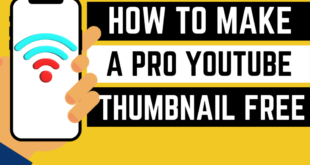How To Speed Up Your Website Explained; A website’s load speed has become increasingly important to your site’s success, so you’ll want to keep an eye on it.
If it takes too long to load, users will get frustrated and leave the site to go to one of your competitors that loads faster. To give your site the best chance at succeeding, optimize it with these 10 easy ways to improve your website’s load speed. Subscribe To This Youtube Channel For Updates And New Post Notifications
Use static resources instead of dynamic ones
Static resources are files that don’t change often, such as CSS files, images, and JavaScript files. They can be cached by the browser so that subsequent page loads are faster.
On the other hand, dynamic resources are generated on-the-fly and can’t be cached. So if you’re using a lot of dynamic resources, your page load times will suffer. One way How To Speed Up Your Website is to use static resources instead of dynamic ones wherever possible.
Reduce redirects
Redirects are one of the main culprits when it comes to slow-loading websites. By reducing the number of redirects, you can significantly improve your website’s load time. Here are seven ways to do it:
- Use a content delivery network (CDN).
- Optimize your images.
- Minimize HTTP requests.
- Put CSS in the document head and JavaScript at the bottom of the page.
- Avoid landing page redirects.
- Enable compression.
- Leverage browser caching.
Get rid of unnecessary plugins
One of the easiest ways to speed up your website is by getting rid of any unnecessary plugins. Not only do they take up valuable resources, but they can also slow down your site.
If you’re not using a plugin, get rid of it! Remember that all these small changes add up and can make a big difference.
Increase DNS lookup timeouts
One way How To Speed Up Your Website is by increasing the DNS lookup timeouts. This will help ensure that your website can be accessed faster by visitors.
By increasing the DNS lookup timeouts, you can also improve the user experience on your website. Here are seven easy ways to do this:
- Use a content delivery network (CDN).
- Optimize your images.
- Minimize HTTP requests.
- Use caching.
- Minify your CSS and JavaScript files.
- Reduce redirects.
- Enable compression
Getting rid of Flash content Is Another On Way How To Speed Up Your Website
Flash content is a common culprit when it comes to slow-loading websites. If you have any Flash content on your site, try to replace it with HTML5 or another alternative. Not only will this improve your load time, but it will also make your site more accessible to users on mobile devices and computers that don’t have Flash installed.
Use lazy loading on videos, scrolling, and AJAX content
Lazy loading plugins are a great way to improve your website’s load speed. By only loading content when it is needed, you can drastically improve the amount of time it takes for your page to load.
Additionally, using lazy loading on videos, scrolling, and AJAX content can also help improve your website’s load speed. You can also check out other best recommended methods here
Avoid using JavaScript for animations
JavaScript is a great tool for creating animations and other interactive content. However, it can also add significant weight to your page, making it load slower. If you’re looking to improve your website’s load speed, avoid using JavaScript for animations. Instead, try using CSS3 or other animation tools.
Remove unused CSS from header tags
One way to improve your website’s load speed is by removing unused CSS from header tags. This can be done by opening your web inspector and looking for any unused CSS styles in the head of your document.
Once you find them, you can remove them from your code or just comment them out. This will help reduce the size of your HTML file and improve your website’s load speed.
Stop Using Background Music
Background music can be a great way to set the tone for your website and make it more engaging. However, it can also be a major contributor to slow loading times. That’s because the background music is usually an audio file, and audio files are generally large.
So, if you’re looking to improve your website’s load speed, one of the first things you should do is remove any background music.
Merge CSS and Javascript files
One easy way to reduce the number of HTTP requests your website makes is to merge your CSS and Javascript files into a single file. This can be done manually or with a task runner like Grunt or Gulp.
By doing this, you can reduce the number of files that need to be loaded, which can improve your website’s load speed.
Remove Duplicate Scripts
When you have multiple scripts on your page, they can often conflict with each other or load slowly. By removing duplicate scripts, you can help improve your page’s load speed.
- Go through your code and remove any duplicate scripts.
- If you have multiple scripts that are similar, combine them into one script.
- Minimize the number of HTTP requests by using techniques like CSS sprites and inline images.
Reduce Server Response Time
- Use a content delivery network (CDN).
- Optimize your images.
- Minimize HTTP requests.
- Put CSS at the top and JS at the bottom.
- Reduce the number of plugins you use.
- Minimize redirects.
- Use a faster hosting provider.
Use lightweight markup
Using lightweight markup can help improve your website’s load speed by reducing the amount of code that needs to be parsed by the browser. This can be accomplished by using simpler code, such as HTML5, and avoiding CSS and JavaScript where possible.
In addition, making sure your code is well-organized and minified can also help reduce loading times.
Avoid heavy animated images
One way to improve your website’s load speed is by avoiding heavy animated images. Animated images can be large files that take a long time to load, which can slow down your website. If you must use animated images, try to keep them small and simple.
You can also use other methods to improve your website’s load speed, such as using a content delivery network (CDN).
Remove unnecessary inline styling
Inline styling is code that is written into the HTML of a webpage, rather than in a separate CSS file. This can bloat your code and make your page load slower.
To fix this, remove any inline styling and put it in a separate CSS file instead. You can also use a tool like Autoptimize to do this automatically.
Minimize HTML Tables
Tables are a great way to organize data on a webpage, but they can also add a lot of extra code that the browser has to load.
If you’re using tables for layout, try using CSS instead. This will reduce the amount of code the browser has to load and can improve your website’s load speed.
Move JavaScript to the Bottom
JavaScript is a render-blocking resource. This means that the browser has to wait for the JavaScript to finish loading before it can continue rendering the page. By moving your JavaScript code to the bottom of the page, you can improve your page load speed.
You can also use tools like Google PageSpeed Insights or YSlow (a Firefox plugin) to identify and remove unnecessary HTTP requests and elements on your website. You should also create content that loads asynchronously (rather than blocking on CSS).
Avoid Unnecessary Redirects
Redirects are often used when a website page has been moved to a new URL. When you type in the old URL, the server sends you to the new one. However, each redirect adds a little bit of time to the page load.
So, if you can avoid them, your page will load faster. Here are a few ways to do that:
- Use permanent (301) redirects when you change URLs
- Don’t use too many redirects in a row. Checkout More SEO Related Posts Here
 1blogxyz.com Contents Worth Sharing
1blogxyz.com Contents Worth Sharing



